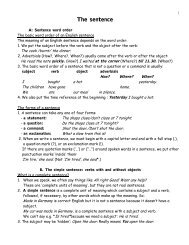Punctuality: How Airlines Can Improve On-Time Performance
Punctuality: How Airlines Can Improve On-Time Performance
Punctuality: How Airlines Can Improve On-Time Performance
You also want an ePaper? Increase the reach of your titles
YUMPU automatically turns print PDFs into web optimized ePapers that Google loves.
Identifying the ‘Real’ Delay<br />
Root Causes<br />
Delays are seldom the<br />
result of one single factor.<br />
In the most cases different<br />
failures in the multitude of<br />
the supporting processes for flight<br />
departure occur together. Traditional<br />
(IATA) delay code based<br />
monitoring systems do not adequately<br />
account for these complex<br />
inter-relationships. Also, the<br />
inherently restricted ‘myopic’<br />
perspective of the people actually<br />
involved in the process prevents<br />
an assessment of the root causes<br />
based upon experience alone.<br />
The typical departure process<br />
is built up from a highly interconnected<br />
web of simple, in some<br />
cases almost trivial activities. It<br />
is the number of different parties<br />
and suppliers which are typically<br />
involved that creates the complexity—and<br />
exacerbates the problems.<br />
In such a system, things can<br />
go wrong, and they do go wrong.<br />
When this happens it is easy to<br />
identify the last and most obvious<br />
disturbance or event that occurred<br />
in the process, and report that<br />
as the cause of delay. This is<br />
the major shortcoming of delay<br />
codes, which usually attribute too<br />
much weight to downstream processes<br />
near the scheduled time of<br />
departure.<br />
There are three basic approaches<br />
to identify the ‘real’ root<br />
causes of delays and to define<br />
improvement levers (exhibit 5):<br />
Exhibit 5. Three Approaches for Identifying the ‘Real’ Delay Root Causes<br />
1<br />
2<br />
3<br />
Process monitoring and sampling<br />
Simulation<br />
Conventional analytical methods<br />
— Delay code frequency<br />
— Fishbone diagrams<br />
— Correlation analysis<br />
Source: Booz·Allen & Hamilton<br />
“<br />
— Process monitoring<br />
and sampling<br />
— Simulation<br />
— “Conventional” methods<br />
Process Monitoring<br />
and Sampling<br />
Analysis Approach Where suited?<br />
Process Monitoring and<br />
Sampling” establishes a<br />
database to evaluate process<br />
performance in the overall<br />
departure process, supplier processes,<br />
and the activities in problem<br />
areas.<br />
Process monitoring requires<br />
that key milestones in the departure<br />
process are defined and measured.<br />
Some airlines conduct spot<br />
checks on such milestones, taking<br />
samples from a number of flights<br />
Operations: overall departure<br />
and all major sub processes<br />
Analysis of specific problem areas<br />
Supplier and quality management<br />
Network and schedule design<br />
Some special ground operation topics<br />
— with single simulation “entities”<br />
— e.g. gate/stand allocation<br />
First-cut problem identification<br />
Supporting cross-functional discussions<br />
and problem solving<br />
Supplementary to methods 1 and 2<br />
9




